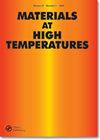Effect of NaCl and SO2 on the stress corrosion cracking of CMSX-4 at 550°C
IF 0.9
4区 材料科学
Q4 MATERIALS SCIENCE, MULTIDISCIPLINARY
引用次数: 0
Abstract
ABSTRACT In the pursuit of more efficient gas turbine engines, components are required to operate for longer times at elevated temperatures. This increased time in service, together with a complex loading regime, can expose the material to environmental attack. This work has demonstrated that the interaction of stress, NaCl and a sulphur-containing environment is critical to cause crack initiation in the early stages of the exposure and accelerated corrosion rates in CMSX-4 at 550°C. The effect of having small concentrations of moisture in the gaseous environment or as water crystallisation in the salt is still to be investigated. A working hypothesis is that the interaction of alkali chlorides with a sulphur-containing atmosphere is the trigger to a self-sustaining cycle where metal chloride formation, vaporisation and oxidation lead to high amounts of hydrogen injection in a rapid manner and, therefore, hydrogen embrittlement.NaCl和SO2对550℃CMSX-4应力腐蚀开裂的影响
为了追求更高效的燃气涡轮发动机,部件需要在高温下工作更长时间。这种增加的使用时间,加上复杂的加载制度,可以使材料暴露于环境攻击。这项工作表明,应力、NaCl和含硫环境的相互作用是导致CMSX-4在550°C时暴露早期产生裂纹和加速腐蚀速率的关键。在气体环境中有少量水分或在盐中有水结晶的影响仍有待研究。一个可行的假设是,碱氯化物与含硫大气的相互作用触发了一个自我维持的循环,在这个循环中,金属氯化物的形成、汽化和氧化导致大量的氢以快速的方式注入,因此,氢脆。
本文章由计算机程序翻译,如有差异,请以英文原文为准。
求助全文
约1分钟内获得全文
求助全文
来源期刊

Materials at High Temperatures
工程技术-材料科学:综合
CiteScore
1.90
自引率
15.40%
发文量
58
审稿时长
>12 weeks
期刊介绍:
Materials at High Temperatures welcomes contributions relating to high temperature applications in the energy generation, aerospace, chemical and process industries. The effects of high temperatures and extreme environments on the corrosion and oxidation, fatigue, creep, strength and wear of metallic alloys, ceramics, intermetallics, and refractory and composite materials relative to these industries are covered.
Papers on the modelling of behaviour and life prediction are also welcome, provided these are validated by experimental data and explicitly linked to actual or potential applications. Contributions addressing the needs of designers and engineers (e.g. standards and codes of practice) relative to the areas of interest of this journal also fall within the scope. The term ''high temperatures'' refers to the subsequent temperatures of application and not, for example, to those of processing itself.
Materials at High Temperatures publishes regular thematic issues on topics of current interest. Proposals for issues are welcomed; please contact one of the Editors with details.
 求助内容:
求助内容: 应助结果提醒方式:
应助结果提醒方式:


